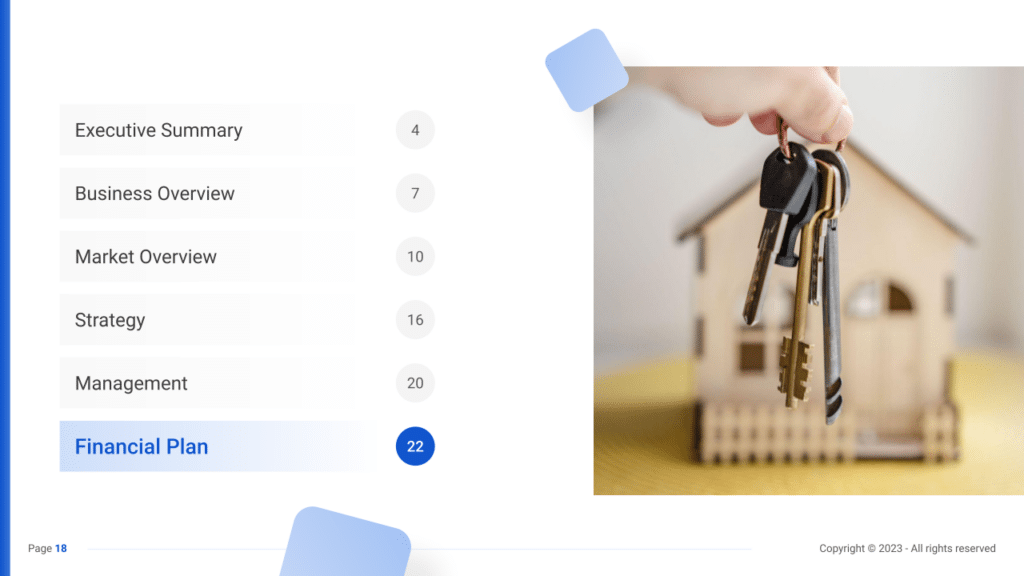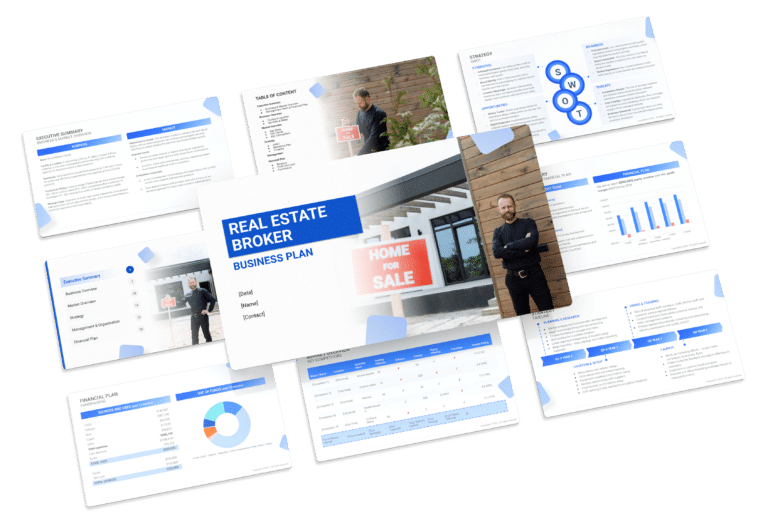Property Management Business Plan Template & PDF Example

Creating a comprehensive business plan is crucial for launching and running a successful property management business. This plan serves as your roadmap, detailing your vision, operational strategies, and financial plan. It helps establish your property management business’s identity, navigate the competitive market, and secure funding for growth.
This article not only breaks down the critical components of a property management business plan, but also provides an example of a business plan to help you craft your own.
Whether you’re an experienced entrepreneur or new to the real estate industry, this guide, complete with a business plan example, lays the groundwork for turning your property management business concept into reality. Let’s dive in!
The Plan
Our property management business plan is designed to cover all essential aspects needed for a comprehensive strategy. It outlines the property management operations, marketing strategy, market environment, competitors, management team, and financial forecasts.
- Executive Summary: Offers an overview of the property management business concept, market analysis, management, and financial strategy.
- Business Overview: Provides detailed information on the property management services and fee structure:
- Services & Fees: Details the range of property management services offered, including tenant placement, maintenance coordination, and financial administration, along with a clear breakdown of the fee structure for each service.
- Market Overview: Examines the property management industry landscape, identifying competitors and how the business stands out:
- Key Stats: Shares industry size, growth trends, and relevant statistics for the property management market.
- Key Trends: Highlights recent trends affecting the property management sector, such as technological advancements and urbanization.
- Key Competitors: Analyzes main competitors in the area and how the business differentiates from them in terms of service quality and technological innovation.
- Strategy: Outlines how the property management business intends to achieve growth and attract clients:
- SWOT: Strengths, weaknesses, opportunities, and threats analysis.
- Marketing Plan: Strategies for promoting the property management services to attract and retain property owners and investors.
- Timeline: Key milestones and objectives from start-up through the first year of operation.
- Management: Information on who manages the property management business and their roles.
- Financial Plan: Projects the business’s financial performance, including revenue, profits, and expected expenses.

Executive Summary
The Executive Summary introduces your property management business plan, providing a succinct overview of your company and its services. It should detail your market positioning, the range of property management services you offer, including residential, commercial, or specialized properties you manage, its location, size, and an outline of day-to-day operations.
This section should also discuss how your property management business will integrate into the local real estate market, including the number of direct competitors within the area, identifying who they are, along with your company’s unique selling points that differentiate it from these competitors. This could include specialized services, exceptional customer service, innovative technology use, or strong community ties.
Furthermore, you should include information about the management and co-founding team, detailing their roles and contributions to the company’s success. Experience in real estate, business management, or specific property management skills could be highlighted here.
Additionally, a summary of your financial projections, including revenue and profits over the next five years, should be presented here to provide a clear picture of your company’s financial plan. This may include growth strategies, potential market expansion, and plans for scaling operations to meet market demands.
Property Management Business Plan Executive Summary Example


Business Overview
The business overview of Prime Property Managers should detail the company’s operational structure, including the range of property management services offered and the number of agents. It’s important to emphasize the diverse revenue streams and how the company caters to the needs of its target market in the Austin area.
Example:
Prime Property Managers, headquartered in Austin, Texas, boasts a team of 5 certified property management agents. The company offers comprehensive services like tenant screening, maintenance, and legal compliance. Its revenue streams include management fees and various service charges, catering to urban residential and commercial properties in Travis County.
Market Overview
A market analysis for the property management industry should include an evaluation of the industry’s size, growth trajectory, and emerging trends. This analysis positions your business within the broader industry and identifies key areas where you can capitalize on current market demands and shifts.
Example:
Prime Property Managers is part of a U.S. property management market valued at $99.5 billion. With 326,000 companies managing properties nationwide, the market offers opportunities for differentiation through quality service and technological advancements. The company’s focus on tech-enabled services and eco-friendly solutions aligns with current industry trends.
Management Team
This section should outline the background and expertise of the management team, highlighting how their experience in real estate and operational management contributes to the strategic direction and operational success of Prime Property Managers.
Example:
The CEO, with 15 years in real estate management, leads the company’s strategic initiatives and client relations. The COO, experienced in operational management and technology, oversees the integration of innovative solutions to enhance service efficiency.
Financial Plan
The financial plan overview should include revenue targets and profit margin goals. This section provides a clear picture of the financial aspirations of Prime Property Managers and its projected financial health and growth.
Example:
Prime Property Managers aims to achieve $2.4 million in annual revenue with a 16% EBITDA margin by 2028. This ambitious yet achievable target is underpinned by a strategic approach to market positioning, operational efficiency, and a focus on leveraging technology in property management.
Business Overview
Services & Fees
Detail the range of property management services offered, from tenant screening and leasing to maintenance, repairs, and financial reporting. Outline your pricing strategy, ensuring it reflects the quality and comprehensiveness of services provided and aligns with the market you’re targeting.
Highlight any value-added services, such as 24/7 emergency response, online tenant and owner portals, or energy efficiency programs, that differentiate your business from competitors, encouraging long-term contracts and client loyalty.
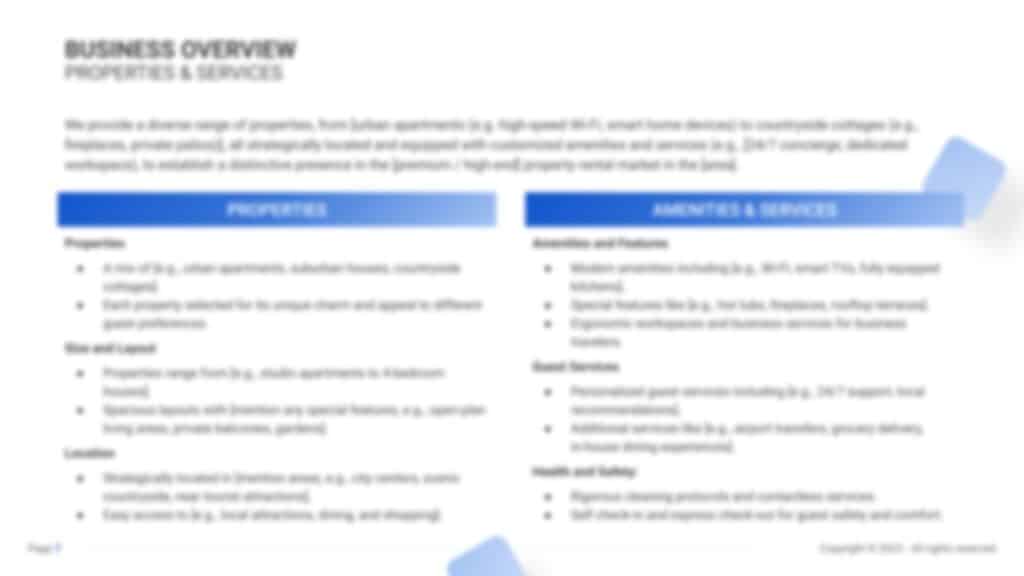
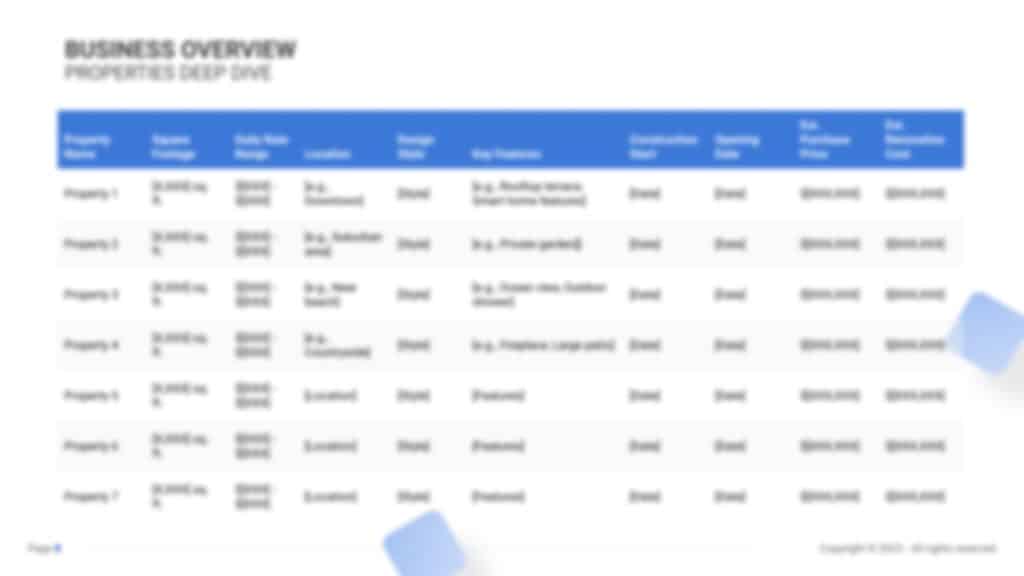
Market Overview
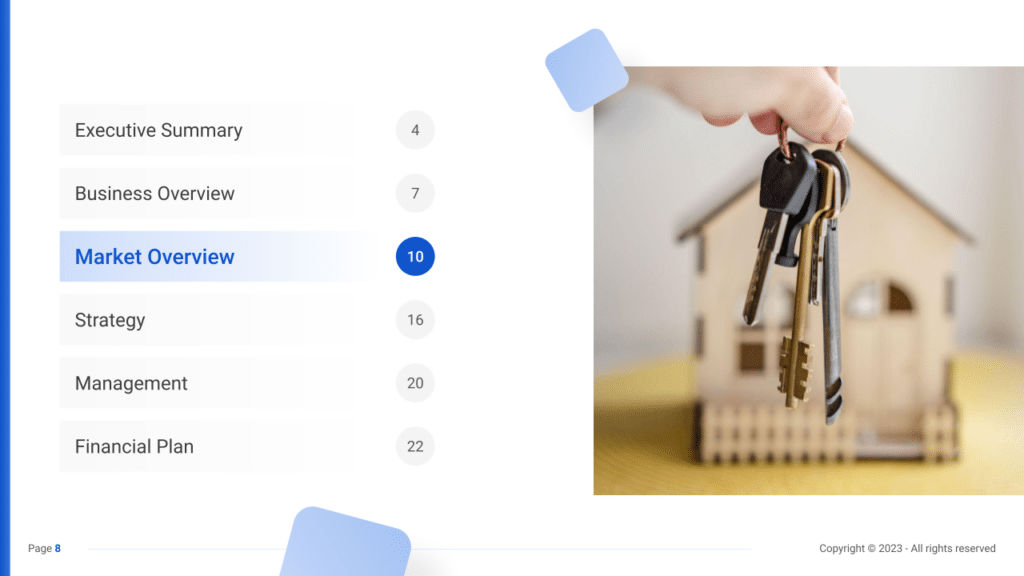
Industry size & growth
In the Market Overview of your property management business plan, start by examining the size of the property management industry and its growth potential.
This analysis is crucial for understanding the market’s scope and identifying expansion opportunities, such as emerging real estate markets, shifts in residential and commercial property ownership, and the increasing demand for professional property management services due to the complexity of managing properties.
Key market trends
Proceed to discuss recent market trends, such as the growing importance of technology in property management, including the use of property management software for efficiency, the rise of smart home technology in residential properties, and the emphasis on sustainable and green building practices.
For example, highlight the demand for services that cater to energy-efficient buildings, the integration of smart home devices in property management, and the increasing expectation for online tenant services and communications.
Competitive Landscape
A competitive analysis is not just a tool for gauging the position of your property management service in the market and its key competitors; it’s also a fundamental component of your business plan.
This analysis helps in identifying your property management service’s unique selling points, essential for differentiating your business in a competitive market.
In addition, competitive analysis is integral in laying a solid foundation for your business plan. By examining various operational aspects of your competitors, you gain valuable information that ensures your business plan is robust, informed, and tailored to succeed in the current market environment.
Identifying Your Competitors in Property Management
The initial phase of a competitive analysis involves identifying and comprehending the landscape of your competitors in the property management sector. Begin by delineating local property management firms, real estate agencies, and freelance property managers operating within your targeted areas.
For instance, if your service specializes in residential property management, your direct competitors might include established property management companies known for their expertise in maintaining residential properties. However, don’t disregard indirect competitors like real estate agencies that offer property management services as part of their comprehensive real estate solutions.
Online resources like industry directories, property management association listings, and real estate platforms can aid in mapping out the competition. Additionally, platforms such as Yelp or Google Reviews might offer valuable insights through client feedback, highlighting competitors’ strengths, like prompt maintenance services or exceptional tenant relations.

Property Management Competitors’ Strategies
Examining the strategies employed by competitors involves a multifaceted approach:
- Service Offerings: Scrutinize the array of services provided by competitors. For instance, if a rival company, “Efficient Property Management,” is gaining traction due to its integrated smart home solutions, it signifies a trend towards technology-driven property management services.
- Management Approach: Consider the management style adopted by competitors. A firm like “Community Care Properties,” known for its personalized approach and community engagement, might attract a different clientele compared to a larger-scale company focused on efficient and scalable operations.
- Pricing Structure: Compare pricing models offered by competitors. Assess whether your service aligns with budget-friendly options akin to “Value Estate Management” or caters to premium clientele similar to “Elite Property Services.”
- Marketing Strategies: Analyze competitors’ marketing tactics. Are they leveraging digital marketing extensively or relying more on traditional advertising methods? Understanding their marketing channels helps shape your promotional strategies.
- Client Experience: Evaluate the customer experience provided by competitors. Perhaps “Reliable Rentals Management” excels in tenant satisfaction through quick issue resolution, while “Eco Living Properties” prioritizes eco-friendly practices, appealing to environmentally conscious landlords and tenants.
- Operational Efficiency: Observe if competitors are leveraging technology for streamlined property maintenance and client communication, such as “Tech-Savvy Estates,” utilizing advanced property management software.
What’s Your Property Management Service’s Value Proposition?
Delve into your property management service’s unique value proposition. It could be your specialization in managing luxury properties, a focus on sustainable property maintenance practices, or an emphasis on fostering strong landlord-tenant relationships.
Identify market gaps through tenant and landlord feedback, industry trends, and unmet demands. For instance, the rising interest in eco-friendly properties could represent an opportunity if competitors have not tapped into this niche.
Consider your target market and location. Tailor your property management services to suit the specific needs of landlords and tenants in your area, whether it’s catering to upscale neighborhoods with personalized services or catering to student housing areas with cost-effective solutions.
Strategy
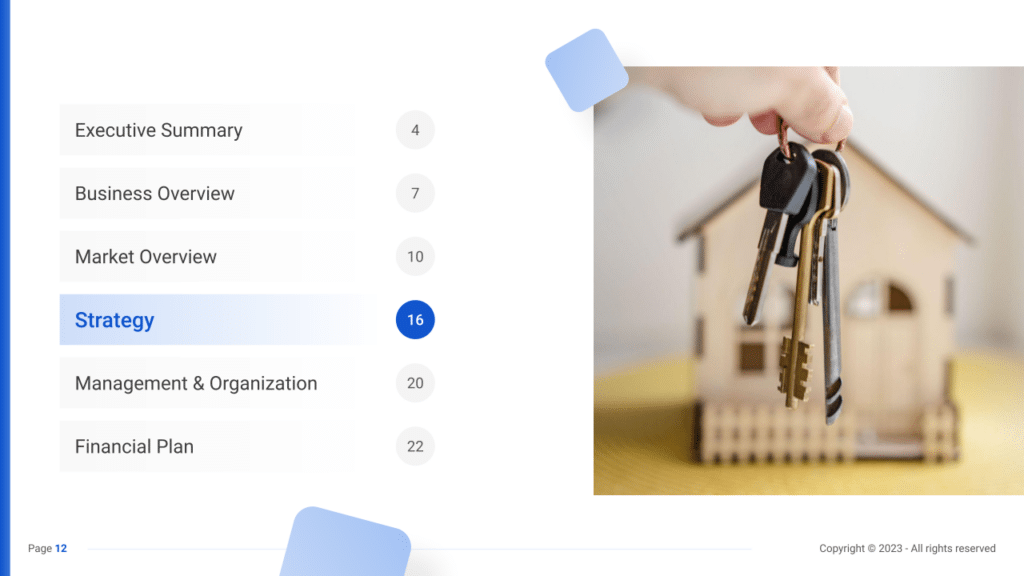
SWOT
First, conduct a SWOT analysis for the property management business, highlighting Strengths (such as experienced management team and comprehensive property management solutions), Weaknesses (including potential scalability issues or limited market presence), Opportunities (for example, expanding real estate markets and increasing demand for rental properties), and Threats (such as regulatory changes affecting property management or economic factors impacting real estate investments).

Marketing Plan
Next, develop a marketing strategy that outlines how to attract and retain property owners and investors through targeted advertising, competitive service offerings, an engaging online presence, and involvement in local real estate communities. Focus on demonstrating your company’s value proposition, such as reducing property owners’ operational burdens, maximizing rental income, and maintaining high tenant satisfaction levels.
Marketing Channels
Utilize various marketing channels to establish brand awareness, engage with property owners, and attract new clients.
Digital Marketing
- Website and SEO: Develop a user-friendly website showcasing your services, client testimonials, and educational content about property management. Optimize it for local SEO to rank higher in search engine results.
- Content Marketing: Produce informative blog posts, guides, or videos addressing property management challenges, investment tips, and market trends to position your business as an industry authority.
- Email Marketing: Build an email list and send newsletters with updates on the real estate market, new property listings, and management strategies.
Local Advertising
- Networking and Events: Attend local real estate meetups, industry conferences, and property investment seminars to network with potential clients and establish credibility.
- Sponsorships and Partnerships: Collaborate with real estate agencies, home improvement businesses, or local chambers of commerce to sponsor events or offer joint promotional deals.
Promotional Activities
- Free Consultations: Offering complimentary property management consultations allows prospective clients to experience the quality of your services firsthand. These consultations are an opportunity to showcase your expertise, address their concerns, and propose tailored solutions, thereby increasing the likelihood of acquiring new clients.
- Referral Programs: Implementing referral programs incentivizes existing clients to refer your services to other property owners. Rewards, such as discounts on management fees or additional services, motivate clients to advocate for your business within their networks, driving referrals and expanding your client base.

Sales Channels
Implement effective sales strategies to convert leads into clients and maximize revenue streams.
Consultative Sales
- Personalized Proposals: Tailoring personalized proposals addressing the unique needs of property owners demonstrates your understanding of their concerns. Offering solutions that align with their property management requirements strengthens your position as a trusted partner.
- Client Education: Client education is key; providing valuable information on regulatory updates, rental market trends, and how your management services can optimize their property’s performance adds value and enhances the client’s understanding of the benefits your services offer.
Online Booking and Sales
- Client Portals: User-friendly client portals offering comprehensive access to property-related information, financial reports, maintenance updates, and tenant information streamline communication and foster transparency. This convenience enhances the client’s experience and facilitates effective decision-making.
- E-Signatures and Contracts: E-signatures and digital contracts simplify the process of onboarding new clients. Implementing secure online platforms for contract signing minimizes administrative hurdles, expediting the client acquisition process.
Subscription-Based Services
- Tiered Service Packages: Offering tiered service packages allows property owners to choose services that align with their needs. Options ranging from basic maintenance to comprehensive tenant management cater to diverse client preferences, increasing the appeal of your services.
- Retainer Agreements: Long-term retainer agreements with discounted rates for bundled services incentivize property owners to commit to your services for an extended period, ensuring stable revenue streams and fostering long-term relationships.
Strategy Timeline
Finally, create a detailed timeline that outlines critical milestones for the property management business’s establishment, marketing initiatives, client portfolio growth, and service expansion objectives. This timeline should ensure the business progresses with clear direction and purpose, setting achievable goals for short-term wins and long-term growth.

Management
The Management section focuses on the property management business’s management and their direct roles in daily operations and strategic direction. This part is crucial for understanding who is responsible for making key decisions and driving the property management business towards its financial and operational goals.
For your property management business plan, list the core team members, their specific responsibilities, and how their expertise supports the business.
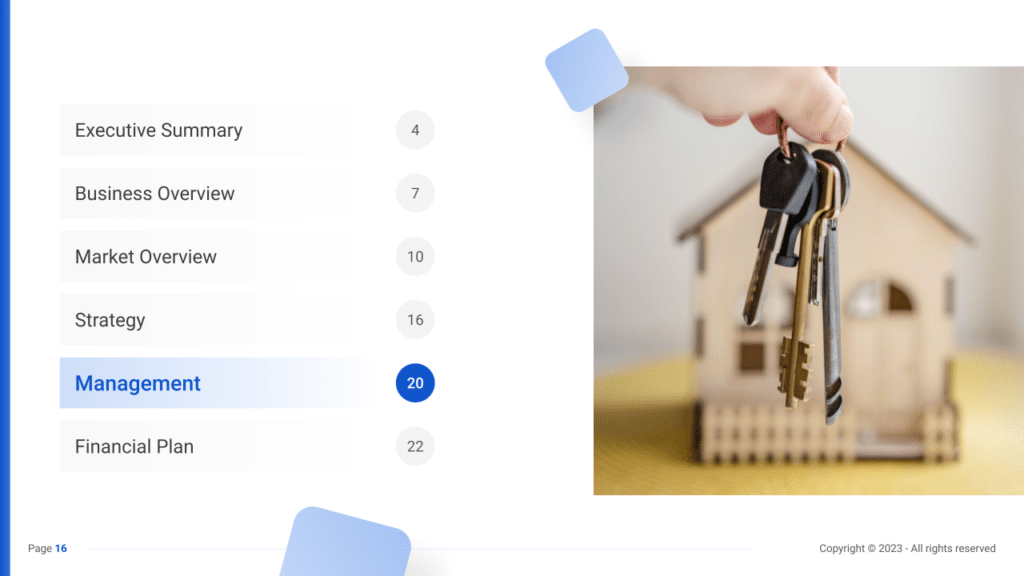

Financial Plan
The Financial Plan section is a comprehensive analysis of your financial projections for revenue, expenses, and profitability. It lays out your property management business’s approach to securing funding, managing cash flow, and achieving breakeven.
This section typically includes detailed forecasts for the first 5 years of operation, highlighting expected revenue, operating costs and capital expenditures.
For your property management business plan, provide a snapshot of your financial statement (profit and loss, balance sheet, cash flow statement), as well as your key assumptions (e.g. number of customers and prices, expenses, etc.).
Make sure to cover here
_ Profit and Loss
_ Cash Flow Statement
_ Balance Sheet
_ Use of Funds
